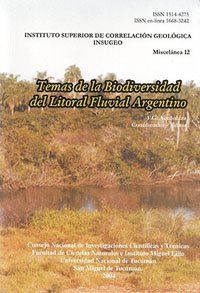Miscelánea 12
Biodiversidad de moluscos de agua dulce de la Región Mesopotámica, Argentina
Alejandra Rumi | Diego E. Gutiérrez Gregoric | Verónica Núñez | Mónica P. Tassara | Stella M. Martín | M. Fernanda López Armengol | Andrea Roche
Descargar trabajo en formato PDFAbstract
BIODIVERSITY OF FRESHWATER MOLLUSKS IN MESOPOTAMIAN REGION, ARGENTINA. Mollusks constitute the second Phyla most numerous in species, after arthropods. The benefits and negative impacts that they produce in human, justify the study of their richness, distribution and diversity in areas of the Argentinean Mesopotamia, where are important urban centers. In Argentina, there are 169 freshwater species, 6 exotic, 105 gastropods and 64 bivalves. Mollusks with negative impacts involve Planorbidae, Lymnaeidae, Chilinidae, Physidae (Gastropoda); Corbiculidae and Mytilidae (Bivalvia). Endemic species of the Mesopotamia: 4 belongs to Chilinidae, 3 to Thiaridae, 3 to Ampullariidae and 11 to Lithoglyphidae. Aylacostoma species (Gastropoda Thiaridae) are threatened.
Aims: 1) to compile a list of freshwater mollusks of the area. 2) to analyze the distribution patterns and diversity, that allow to determine the threatened species and to actualize the distribution of health interest, aliens and agricultural pest species. 3) to categorize the mollusks according to their conservation interest.






